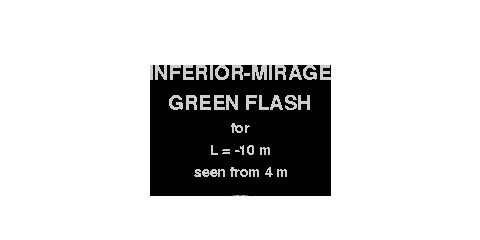
Here's the inferior-mirage flash, seen from a height of 4 meters above sea level:

Notice that the ordinary orange part of the disk is surrounded by a colored fringe, which is widest at the left and right ends of the elongated image. This image is really a double image of a small part of the upper limb of the Sun: its lower half is essentially the inverted, miraged image of the upper limb again. At first, that lower half is appreciably flatter than the upper one, because it's a reflection in a convex (reducing) mirror, owing to the curvature of the Earth.
Also, notice that the disappearing spot is well above the apparent horizon. That's because the apparent horizon is really just the boundary between the mirage and the foreground; the sky just above it is a miraged reflection of the sky a little higher up. In fact, you'll see from the scales that the apparent horizon here is about 6 minutes of arc below the astronomical one, although in the Standard Atmosphere sunset, viewed from the same height, the dip of the sea horizon was only about half as much.
The separation between the flash and the sea horizon depends on the height of the waves: the higher the waves, the more they cut off the bottom of the inverted image, and the higher the apparent horizon is. This simulation assumes a fairly calm sea, which makes the separation between the flash and the sea horizon a bit larger than is typical.
The flash itself appears where the erect and inverted images join. At this level, there's a narrow zone of sky parallel to the horizon that has very great vertical magnification. When the green rim reaches this stretching zone, it's magnified enough to be visible to the naked eye.
© 1999 – 2005, 2006, 2013 Andrew T. Young